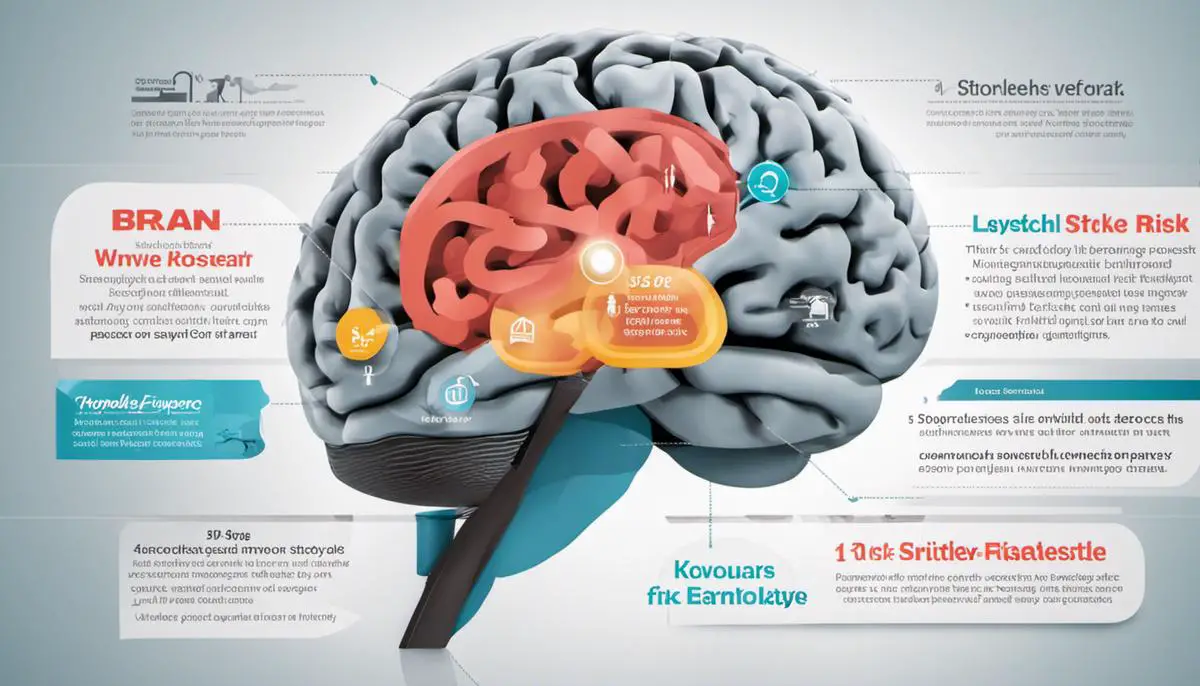The power of physical activity in promoting health and wellness extends far beyond enhancing physical strength and endurance – it can actually protect you from potentially life-threatening conditions such as stroke. Stroke, a medical emergency caused by an interruption or reduction in the brain’s blood supply, must be understood in its totality, from symptoms to risk factors, to acknowledge its profound implications. Along with this comprehensive understanding, the pivotal role of physical activity in not just maintaining overall health, but specifically mitigating stroke risk, becomes evident. By exhibiting how daily exercise manages factors such as blood pressure, circulation, and weight, and subsequently outlining practical steps toward a healthier lifestyle, we highlight how physical activity can serve as a potent defense line against strokes.
Understanding Stroke and Its Risk Factors
Understanding Stroke: Its Nature, Symptoms, and Types
A stroke occurs when a blood vessel that carries oxygen and nutrients to the brain is either blocked by a clot or bursts. When that happens, part of the brain cannot get the blood (and oxygen) it needs, resulting in brain cells dying. The devastating condition is the fifth leading cause of death in the United States.
Symptoms of stroke can include sudden numbness or weakness in the arm, the leg, or face, typically on one side of the body. Stroke patients can also experience severe headache without a known cause, difficulty walking, trouble speaking or understanding speech, and impaired vision in one or both eyes.
There are mainly two categories of strokes, ischemic and hemorrhagic. Ischemic stroke comprises around 87% of all strokes and transpires when the arteries to your brain are constricted or blocked, hindering adequate blood flow. Hemorrhagic stroke happens when a blood vessel in your brain leaks or ruptures.
Risk Factors Associated with Stroke
Stroke is a multifactorial disease, which means it doesn’t have a singular cause. It can derive from a variety of risk factors, including age, lifestyle, genetics, and environmental aspects.
Lifestyle risk factors include lack of physical activity, unhealthy diet, obesity, heavy or binge drinking, and the use of illicit drugs. Additionally, medical risk factors include high blood pressure, high cholesterol, diabetes, obstructive sleep apnea, and cardiovascular diseases.
Genetic factors also play a significant role in stroke risk. Family history of stroke or certain genetic disorders like sickle cell disease can increase the susceptibility to stroke. Lastly, environmental elements like air pollution and exposure to secondhand smoke can also play a part in elevating stroke risk.
Physical Activity and Stroke Prevention
Physical activity resides at the forefront of preventive measures for stroke. Regular exercise helps control blood pressure, increase levels of high-density lipoprotein cholesterol (the “good” cholesterol), and improve overall cardiovascular health. It may also aid in weight management, reducing obesity—a significant risk factor for stroke.
Studies show that adults who engage in moderate to vigorous physical activity are less likely to have a stroke than those who are inactive. A minimum of 150 minutes a week of moderate-intensity or 75 minutes a week of high-intensity physical activity can significantly cut stroke risk.
Regular physical activity can also help control other health conditions that increase stroke risk, such as diabetes and high blood pressure. Exercise can be a protective factor against these chronic illnesses, helping to manage glucose levels, blood pressure, and the body’s insulin response.
Physical activity not only helps in stroke prevention but also in recovery. After a stroke, regular physical activity and exercise can help individuals recover by improving balance, coordination, muscle strength, and overall wellness.
Regular physical activity is a major player in prevention strategies against stroke. It benefits a variety of health risk factors by promoting a healthy lifestyle, thus mitigating the chance of stroke significantly. It’s essential, however, to keep in mind that any exercise regimen should come under the guidance of a healthcare provider to ensure it’s tailored to your needs.

The Importance of Physical Activity on Overall Health
The Role of Physical Activity in Total Wellness
Exercise provides a wide-ranging array of health advantages that play a crucial part in enhancing overall wellness. Regular participation in physical activity assists in managing a healthy weight, fortifying muscles and bones, improving sleep quality, and lowering the likelihood of chronic diseases. Physical activity doesn’t just regulate essential body functions like blood pressure and blood sugar – it also boosts cardiac health. Cardiovascular fitness – which reflects how effectively the heart, lungs and blood vessels work to circulate oxygen – is a key factor in sustaining the optimum functioning of different body parts.
Physical Activity and Cardiovascular Health
Physical activity plays an instrumental role in fostering cardiovascular health. Regular exercise helps lower the levels of low-density lipoprotein (LDL or ‘bad’ cholesterol) and elevates high-density lipoprotein (HDL or ‘good’ cholesterol). These changes aid in decreasing plaque build-up in the arteries, reducing blood pressure, and minimizing heart strain, effectively preventing cardiac diseases.
Boosting the Immune System Through Exercise
Physical activities are essential drivers in enhancing the body’s immune function. Regular moderate exercise can stimulate the production of antibodies and white blood cells, which are key to fighting off infections. Furthermore, engaging in consistent exercise may prevent or delay the onset of age-related immune system decline, bolstering the body’s defense mechanisms.
Exercise and Mental Health
The benefits of regular physical activity extend beyond physical wellness and into mental health. Exercise has proven effective in reducing symptoms of depression and anxiety through its role in regulating and modulating various neurotransmitters, including endorphins, dopamine, and serotonin. This, in turn, fosters brain health, improves cognition, and enhances overall psychological wellbeing.
Physical Activity in Reducing Stroke Risk
Physical activity plays a paramount role in reducing stroke risk, a severe health complication often resulting from cardiovascular conditions. Regular exercise helps control weight and blood pressure, reduces harmful cholesterol and boosts beneficial cholesterol, and improves blood flow — all of which are factors contributing to reduced stroke risk. It’s estimated that physically active individuals can lower their risk of stroke by up to 27 percent, depending on the intensity, duration, and frequency of exercise.
Conclusion
Regular physical activity is an essential tool for maintaining wellness and reducing the risk of numerous health complications, including stroke. Exercise not only optimizes your bodily functions but also bolsters resilience against diseases by boosting your immunity and mental health. It’s clear then that embedding a consistent exercise regimen into your daily routine is a proactive and practical strategy for improving health and prolonging life.

Photo by bruno_nascimento on Unsplash
Physical Activity and Its Direct Impact on Stroke Risk
Understanding Stroke and Its Risk Factors
Having recognized the significance of regular exercise, it’s equally essential to understand the health issue at hand – stroke, and the factors that increase its risk. A stroke is a critical health emergency that occurs when the brain’s blood supply is impeded, causing the brain cells to die due to lack of oxygen, potentially resulting in lasting disability or death.
Several risk factors go hand in hand with stroke – some are beyond our control, like age, gender, and genetics. However, many others can be managed through modifications in our lifestyle. Such controllable factors include high blood pressure, smoking, excessive alcohol intake, elevated cholesterol levels, obesity, and physical inactivity. Physical activity, noticeably, is not just an essential wellness tool but also a vital part of mitigating stroke risk.
The Protective Role of Physical Activity
Regular physical activity plays a protective role against stroke. According to the American Stroke Association, being inactive can increase your stroke risk by as much as 50%. This is because physical activity has several benefits that directly counter the risk factors of stroke.
Regulating Blood Pressure
High blood pressure is a leading risk factor for both ischemic and hemorrhagic strokes. Regular physical activity can help to lower blood pressure. The American Heart Association recommends adults aim for a minimum of 150 minutes per week of moderate exercise or 75 minutes per week of vigorous exercise (or a combination of both) to help reduce blood pressure.
Improving Circulation
Physical exercise also improves circulation. Regular exercise makes your heart stronger. A stronger heart pumps blood more efficiently around the body, which then reduces the strain on the circulatory system. This efficient circulation reduces the risk of clots forming, one of the primary causes of stroke.
Weight Control
Obesity is a known risk factor for stroke, primarily due to the link with other risks like hypertension and diabetes. Regular physical activity, in combination with a balanced diet, is the most efficient way to maintain a healthy weight. Lower weight reduces the strain on the heart and the entire circulatory system, and by extension reduces the possibility of stroke.
Reinforcing Benefits with Research Findings
Numerous research findings bolster the connection between regular physical activity and reduced stroke risk. A 2013 study published in the medical journal Stroke, found that people who exercise five or more times per week have a reduced stroke risk. Another study in the Journal of Neurology, Neurosurgery, and Psychiatry found that even light physical activity, such as walking for just 30 minutes a day, resulted in a reduced stroke risk.
In a nutshell, regular physical activity provides numerous health benefits, particularly decreasing the odds of stroke. Consistent exercise – such as jogging, cycling, swimming, or simply walking – drastically lowers the possibilities of confronting this potentially fatal health crisis.

Adopting a Physically Active Lifestyle for Stroke Prevention
Appreciating The Connection Between Stroke Risk and Physical Inactivity
Strokes, the result of an interruption or diminishment in the brain’s blood supply, are severe health hazards that might result in extensive damage, chronic disability, or even death. The American Stroke Association informs us that almost 800,000 people in the US become either new or recurrent victims of stroke every year, thus positioning it among the leading causes of major health devastation. Sedentary lifestyles, characterized by extended periods of inactivity and minimal energy usage, add significantly to this risk.
Numerous studies have demonstrated a straightforward connection between insufficient physical activity and increased stroke risk. Inactivity often leads to obesity, elevated blood pressure, and high cholesterol levels, all recognized risk factors for stroke. Regular aerobic exercise can inversely affect your stroke risk by promoting cardiovascular health, reducing blood pressure, and aiding in weight management.
Recommended Activities and Exercise Levels
It’s crucial to aim for a mixed exercise regimen that incorporates aerobic activities, muscle-strengthening exercises, and activities that improve balance and flexibility. The U.S Department of Health and Human Services provides guidelines for physical activity, suggesting that adults should aim for at least 150 minutes of moderate-intensity or 75 minutes of vigorous-intensity aerobic activity per week. Additionally, they should engage in muscle-strengthening activities of moderate or greater intensity at least two days per week.
For older adults, the guidelines also suggest incorporating balance-training activities to reduce the risk of falls, which could lead to debilitating injuries. Remember, starting with small, achievable steps is key, and any physical activity is better than none at all.
Transitioning from a Sedentary Lifestyle
Transitioning from a sedentary lifestyle to an active one takes time and patience, but the rewards are substantial. Start by breaking up long periods of sitting whenever possible during your day, even small actions such as standing and stretching for a few minutes every hour can make a difference. Gradually increase the duration and intensity of your physical activities to safely adjust to your new lifestyle.
Success stories
Many people have significantly reduced their stroke risk by incorporating physical activity into their daily routines. For instance, a woman named Mary, who was initially at high risk for a stroke due to her sedentary lifestyle, high blood pressure, and obesity, managed to lower her risk by brisk walking for 30 minutes a day, and doing yoga and strength training exercises several times a week. In just a year, she lost a significant amount of weight and reduced her blood pressure to normal levels.
Another example comes from a man named John. John managed to enhance his cardiovascular health and reduce his stroke risk by cycling to work every day rather than taking the bus. He also started participating in a local soccer league on weekends for an extra cardiovascular workout. His doctor reports that John’s regular physical activity has significantly reduced his stroke risk.
These real-life successes underscore the incredible impact of physical activity on reducing stroke risk. They remind us that adopting a more physically active lifestyle, no matter our current fitness level, can lead to significant health benefits.

Adopting an active lifestyle is not only about enhancing our well-being today; it is also about securing our health for the future. Risks associated with strokes can be significantly reduced with consistent physical activity, underscored by countless research and real-life success stories. Balancing our lives with an adequate mix of cardiovascular exercises, strength training, and flexibility routines is a choice we make that directly affects our health trajectory. Different age groups and physical conditions may require a variety of exercises, but the universal truth remains – movement heals. Let the understanding of stroke, the benefits of physical activity, and the insights into their relationship serve as motivating forces to make mindful decisions towards a healthy, vibrant, and stroke-free life.
